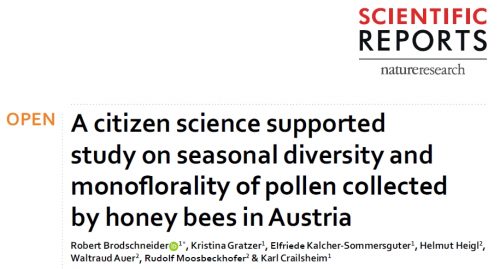Below we show how humans are using pollen in food as the finest and healthy spices you can imaging.

Mixed into homemade chocolate

PREPARATORY ACTION FOR MONITORING OF ENVIRONMENTAL POLLUTION USING HONEY BEES


Last week note nr 2. “Follow your scientist – the INSIGNIA project” by Flemming Vejsnæs was sent out to the stakeholders. it draws the attention to our social media and website to inform and to enhance the cooperation and commitment of the stakeholders to the INSIGNIA project. Soon similar notes will be sent to the beekeeper’s journals in the INSIGNIA countries. More notes will follow
Flemming Vejsnæs, Sjef van der Steen



Now the laboratories are working. Hard working. Analyzing all our samples. And is a lot. And they do an amazing job. They analyze, the give results, they question if that and that substance really is to find in the vicinity of the colonies. We give our best answers. They go back, re-analyze and do it even in another laboratory to exclude mistakes. They are very accurate and careful. They came back, telling that the findings are confirmed. We discus, we wonder, we get surprised and we get very excited on this project. It is like a crime case, where now the forensics are working. And they ask for new samples, to conform a suspicion.
This happens today. They wanted to validate or invalidate some findings. They want to be total sure. So, they asked for honey samples and control samples. So, we did. And nice to visit the colonies, confirming if they are alive. And they are and they look good. But for sure now they are in the wintercluster, so we do not want to disturb them to most and stress them. So, we opened the colonies, gentle and took out a frame with feed, scaping a sampling.
All this for the forensics, to confirm the hypothesis.
This project is so exciting and will bring a lot of new results to the surface.
Flemming Vejsnæs
The University of Almería team is doing their best to analyze the APIStrips and the beebread samples. Up to five people are involved in the extractions, under the direction of Amadeo Rodríguez. 
After samples’ arrival, they are all coded and then analysed or stored in the freezer till the day of analysis. For their preparation, extraction and clean-up steps are taking place, to separate the analytes from interfering compounds and obtain the optimum results. For the quantification of the pesticide residues analysed, both liquid and gas chromatography combined with tandem mass spectrometry is used. The last stage of this procedure is the data analysis and the evaluation of the results.
Lab material and equipment used by the lab staff (us), are presented in the following pictures. In particular, in the picture on the left, 50mL falcons containing salts for the clean-up step of the samples and 15mL falcons containing samples after the clean-up step are shown in the back and front part of the picture, respectively. Vials to be filled and vials ready for injection in LC-MS/MS and GC-MS/MS are also presented in the following pictures.
Effrosyni Zafeiraki

At the IPB (Instituto Politécnico de Bragança in Portugal), the botanical origin of the Insignia pollen is determined molecularly. The botanic origin of pollen is determined by its DNA.
As all living organisms, all plants have DNA, and all plant DNA has an ITS2 (internal transcribed spacer) fragment. This ITS2 fragment is a specific part of the DNA strand and is unique for a plant family/ genus/ species. Of every pollen grain in the homogenised subsamples collected from a pollen trap, beebread and Beehold tube, the Insignia pollen matrices, the ITS2 fragment is isolated and multiplicated to millions of copies by an in vitro reaction called PCR.
Continue reading “Metabarcoding of pollen”
Among other EU countries, Austria will also participate in next year’s INSIGNIA ring-testing. Therefore, we are looking for suitable citizen scientists to accompany us through this process. For this purpose, and to introduce the INSIGNIA project to Austria’s beekeepers, we published an article in “Bienenaktuell”-Austria’s biggest beekeeping magazine. We presented our main project goals and the tested active and passive sampling matrices to the readers and draw attention on Austria’s role in the INSIGNIA project in 2019 and the upcoming year 2020.
Brodschneider & Gratzer (2019) INSIGNIA – Ein EU gefördertes Projekt zur Untersuchung von Pollendiversität und Pestizidrückständen. Bienenaktuell Dezember 2019, 13-15.



In Insignia we are “Monitoring pesticides and pollen diversity via honeybees” – that is the claim on the starting page of this website. But how can one do that, and what are the advantages to do that with citizen scientists? Continue reading “How to study pollen diversity with citizen scientists?”

The colonies in Denmark have been treated for varroa mites, the main killer of honey bee colonies. We know we did treat well during the season with organic treatments. We finished feeding and the bees have slowly started to have what we call “loose” winter cluster. On sunny days with the sun on the bee boxes, the bees do fly out and we even see them collect pollen during those warmer days. The colonies look very fine and strong and we expect them to come into the new season well. Continue reading “Great to have a car”